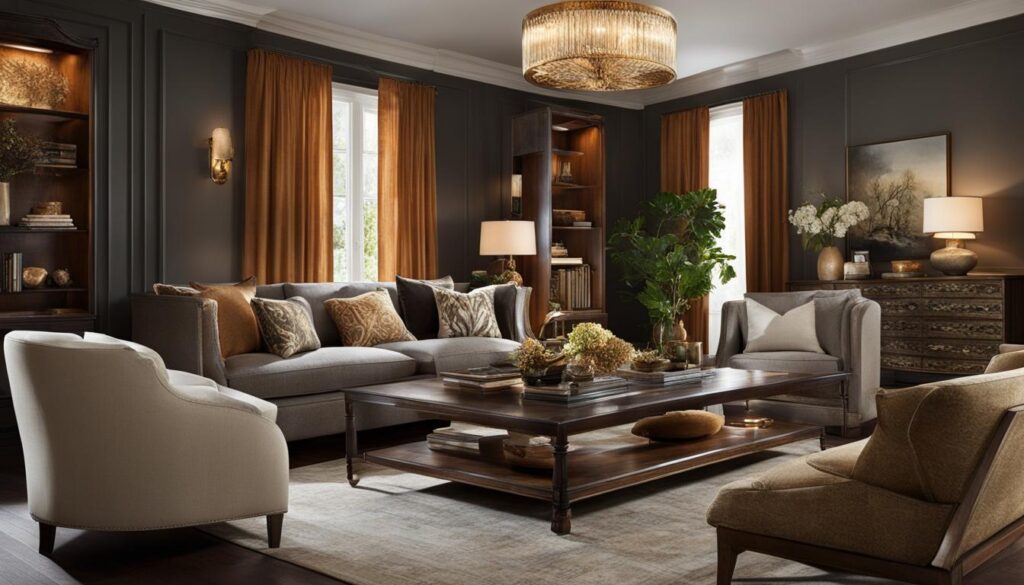As a lover of all things design, I’ve always been fascinated with the art of blending styles within a living space. There’s something profoundly beautiful about integrating old and new decor, creating a tapestry of narratives that makes a home truly personal. Harmonizing vintage and modern elements can transform your interior design approach, moving it away from the fleeting allure of the trendy to achieve a look that’s undeniably timeless. Today, I’m opening the doors to my own exploration of this diverse and dynamic method of styling.
Key Takeaways
- Fusing past and present decor creates interiors that are both historical and timeless.
- Celebrating the patina and craftsmanship of antiques can add depth to a modern living space.
- Blending styles contributes to a layered look that is rich in character.
- An appreciation for different design eras is key to a home that feels both curated and cozy.
- Antiques lend a sense of heritage and story that modern furnishings often seek to emulate.
- Understanding the balance in interior design is crucial when integrating old and new decor.
- A well-mixed space is both trendy and timeless, a testimony to personal style and history.
Defining Modern, Vintage, and Antique
When I walk into a room that harmoniously blends antique furniture with contemporary designs, it’s like stepping into a narrative of design evolution. Understanding the distinct characteristics of modern, vintage, and antique furnishings is essential for creating a modern and antique living room that reflects a savvy interior design touch. Let me guide you through the nuances of these categories.
Firstly, antiques are the grandfathers of interior design; they’ve stood the test of time for over 100 years. Each piece carries a story, etched into its very woodwork and finish. It’s the patina, the craftsmanship, that remains unrivaled, evoking a sense of wonder about the life it has lived.
Then we have vintage items. These pieces are younger than antiques but still possess a rich history of their own. A vintage piece, dating from 20 to 100 years old, often captures the essence of its era, embodying distinctive styles that now infuse character into vintage modern decor.
Modern encompasses a broad spectrum; it could be the sleek and cutting-edge designs popping up in showrooms today or the iconic pieces of midcentury modern design. These are the pieces acclaimed for their clean lines and timeless aesthetic, often acting as a seamless bridge between the old and the new in a well-designed space.
- Antique Furniture: Over 100 years old, imbued with history and craftsmanship.
- Vintage Modern Decor: Circa 20-100 years old, encapsulating the essence of a design era.
- Contemporary Designs: Fresh, of-the-moment pieces that reflect today’s design innovations.
- Midcentury Modern Design: Mid-20th century to early 60s furnishings known for their timeless appeal.
To truly grasp the beauty that comes from combining these elements, it helps to visualize them coexisting. Imagine entering a modern and antique living room, where a sleek contemporary sofa invites you to unwind, while an intricate antique cabinet whispers tales of decades gone by – this is the art of interior design. But it’s not just about aesthetics; it’s about creating a collection that speaks to your personal taste and transcends matchy-matchy conformity.
As you explore the myriad ways to bring together these distinct styles, remember: the goal is to curate a space that is not just a time capsule but a living, breathing reflection of beauty across ages.
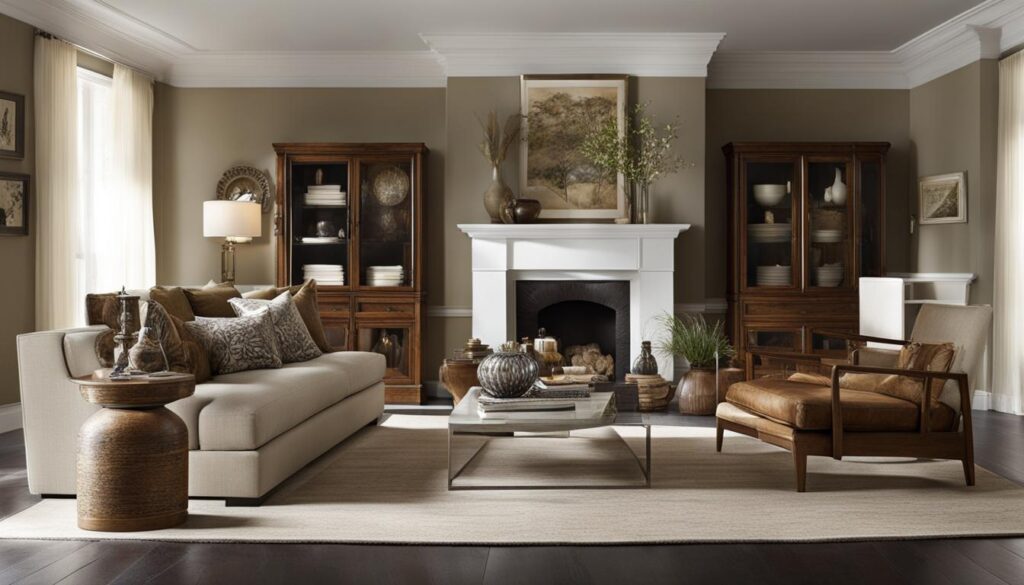

Embracing the Juxtaposition of Eras
In my years of exploring the realms of vintage modern decorating, I’ve come to appreciate the beauty of mixing antiques with modern decor. Not only does this blend of time periods bring an eclectic interior design to life, but it also celebrates the fine craftsmanship of antique furniture within a modern home. The secret lies in honoring the scale in interior design and knowing how to mix vintage and modern furniture to create a space filled with modern comfort and vintage charm.
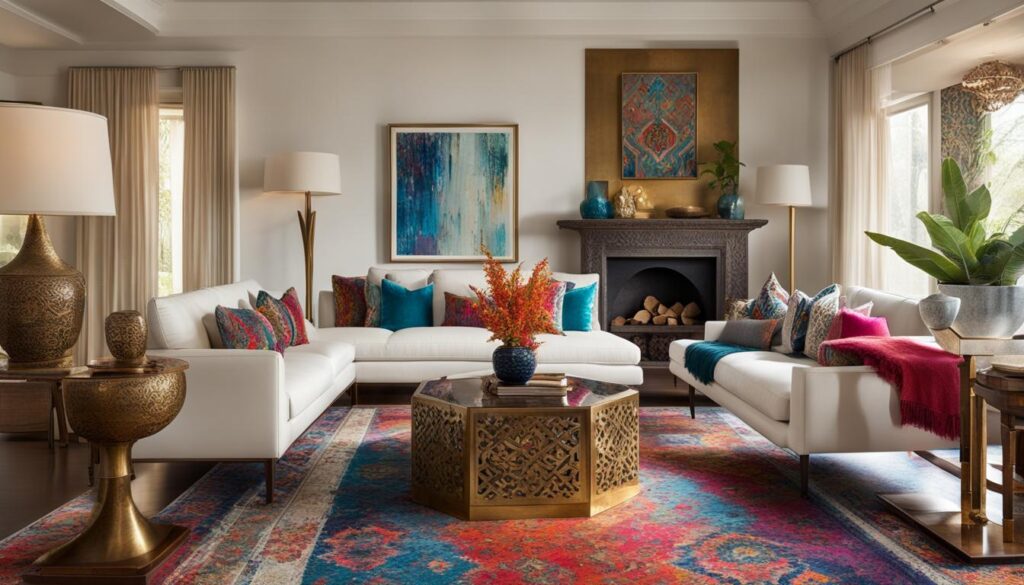

Incorporating Patina and Scale
Whether it’s a stately grandfather clock or a set of rustic Windsor chairs, introducing pieces with a rich patina can set a distinct mood. I find that juxtaposing antiques and modern pieces often requires a careful consideration of scale. Positioning larger antique pieces against walls serves to anchor a room without overwhelming it. Conversely, inserting lighter, contemporary elements keeps the space feeling airy and balanced, allowing an enjoyable interplay between old and new.
Selecting Antiques for Modern Spaces
When integrating old and new, I am drawn to the timeless lines of a classic Chippendale desk or a Victorian chaise lounge. These antique pieces don’t just serve as a nod to history; they’re a testament to a time when fine craftsmanship reigned supreme. Modern antique decor doesn’t merely rest on aesthetics; functionality plays a key role, as I seamlessly blend such pieces into modern settings to evoke both character and usability.
Creative Restorations and Updates
- Refurbishing vintage pieces isn’t about erasing the past—it’s about extending their stories into today’s interiors.
- Refreshing and upcycling antiques, such as giving a new life to an old oak table with a fresh coat of paint, retains its allure.
- I’m particularly fond of refinishing or changing the hardware on vintage dressers, infusing them with a touch of the present while still respecting their structural integrity.
- It’s all about cultivating that unique juxtaposition, a dialogue between the craftsmanship of yesteryear and the sleek sensibilities of contemporary style.
Mixing Modern with Antiques in Room Design
When I embark on the artful journey of designing a living room that combines modern and antique furniture, I often liken it to conducting a symphony. Each piece, whether steeped in tradition or the epitome of modernity, plays its part in creating a harmonious and visually intriguing space. Fusing antique and modern furnishings isn’t just about placing a vintage coffee table next to a contemporary sofa; it’s about finding the balance and creating a dialogue between the two. Bunny Williams, a renowned name in the interior design realm, has been a proponent of this blending ethos for years, showcasing how quality craftsmanship can bridge the gap between centuries.
In my designs, I aim to create environments where vintage meets contemporary in the most seamless fashion. Here is how I approach mixing traditional and modern styles:
- Anchor the Space with a Statement Antique: A grand, heirloom-quality dining table can serve as more than a functional item; it becomes a story, a focal point around which modern accents can congregate.
- Modern Lighting Fixtures: I love to install contemporary lighting fixtures above antique furniture. This illuminates the space with a fresh perspective and draws the eye to the convergence of time periods.
- Update and Repurpose: By rejuvenating old pieces with a coat of paint or new upholstery, I merge the comfort of modern living with the timeless appeal of antiques.
- Consistent Color Palette: Implementing a cohesive color scheme throughout the living room mix of modern and antique furniture ties the elements together, allowing them to coexist gracefully.
Take, for instance, a room where a sleek, modern sofa is juxtaposed with an antique wooden trunk used as a coffee table. The contrast is striking, yet by incorporating a consistent color palette across the room, it looks intentional and curated. Sometimes, the boldness lies in the subtleties, such as the integration of a modern art piece hanging over a beautifully carved vintage console. A living room designed this way is both a nod to our past and a step towards the future.
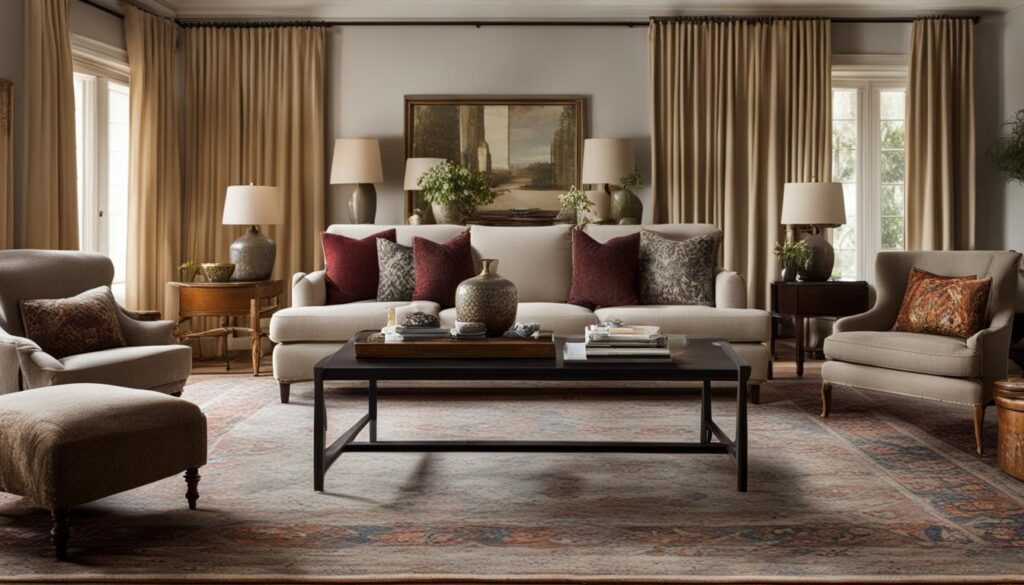

Ultimately, the fusion of different eras reflects a narrative – my own story intertwined with the accumulated tales each piece brings. As a designer, I venerate the patina of antique furnishings just as much as I celebrate the sleek lines of contemporary designs. This enriching interplay between then and now results in a living room that resonates with character and timeless charm, demonstrating that when it comes to personal space, balancing traditional grace with modern practicality isn’t just possible—it’s wondrously transformative.
Creating Harmony with a Unified Color Palette
When it comes to blending old and new in your home, a harmonious color palette is central to successful eclectic interior design. This approach allows you to mix vintage and modern furniture in such a way that they complement each other, making your room design both vibrant and balanced.
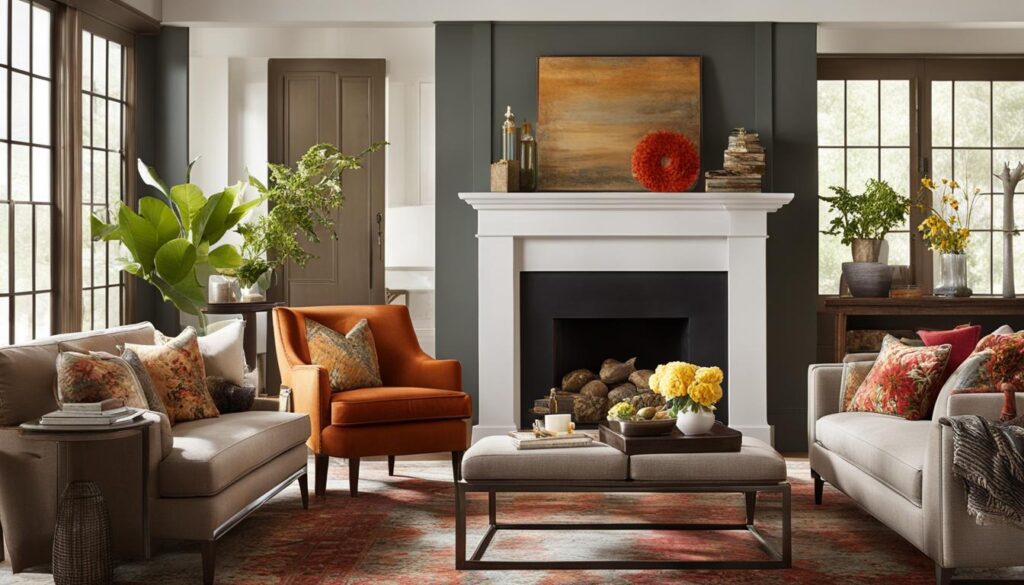

I’ve found that one of the most accessible methods to achieve a cohesive room design is to draw inspiration from shabby chic interiors. This style is adept at mixing antiques with modern decor by using a soft and neutral color scheme as a foundation for the various eras of design represented in your space.
Uniting Disparate Elements
A shared color scheme is like a visual thread that can tie together diverse decor elements. Using a select palette allows me to weave together a tapestry of harmonizing vintage and modern elements without overwhelming the senses. The continuity of color helps create a dialogue between the high gloss of modern finishes and the muted patina of vintage finds.
Focusing on Cohesion through Shabby Chic Inspiration
The warmth and lived-in comfort inherent to shabby chic design offer great lessons for blending old and new. Creamy whites, distressed wood, and plush upholstery are hallmarks of this look, which excels in mixing modern and vintage decor. By painting thrift store treasures in chalky pastels or soft neutrals, we can unify disparate pieces and emphasize the importance of form and function.
- Start small by incorporating mirrors and lighting fixtures to introduce vintage charm into modern settings.
- Use statement rugs to anchor the space, setting a dynamic stage for a conversation between eras.
- Consider contemporary lighting to not just illuminate but also modernize a room’s ambiance.
Remember, creating a harmonious blend isn’t just about appearance; it’s a narrative that unfolds in your living space, telling the story of a thoughtful and well-curated life.
Strategic Placement of Statement Pieces for Maximum Impact
When I dive into mixing modern and vintage decor, the highlight is often on statement pieces that command attention. It’s about creating a visual dialogue between vintage modern decorating elements and the crisp lines of a modern and antique living room. Let’s be strategic; every piece should have its moment.
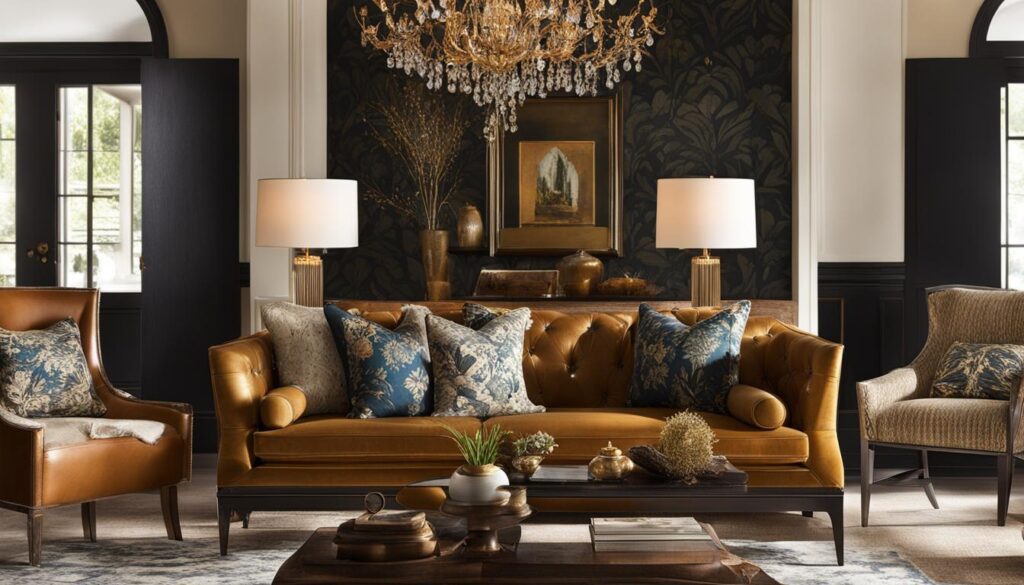

Consider a large, opulent antique mirror. I place it on a minimalist background, allowing its intricate frame to spark curiosity and pull the room together. The contrast between new and old adds layers of depth to my living space.
In selecting these pieces, I focus on how each one interacts with the room. They’re not just furnishings; they’re conversations. A meticulously restored farmhouse table, for example, deserves a place of honor where its history and renewed beauty can be celebrated amidst modern comforts.
- Identify a focal point – a place where the eyes naturally rest and where a vintage piece can stand out.
- Balance – offsetting a vintage statement piece with simpler modern elements cultivates coherence.
- Contrast – playing with textures and colors can accentuate the unique features of both modern and vintage pieces.
Through careful placement, a room transforms into a narrative of my journey through time, a seamless blend of history and the here and now.
Conclusion
Incorporating old and new elements in interior design is an art form that creates rhythm within a space, much like a well-composed piece of music. Finding the perfect balance when mixing modern with antiques isn’t just about following trends; it’s about narrating a story that resonates with my personal experiences and tastes. Vintage modern decor isn’t simply about aesthetics—it’s a dialogue between times and traditions, resulting in a rich tapestry of style.
As I endeavor to advise on how to mix vintage and modern decor, the main theme has always been harmony. Each element, whether a sleek contemporary lamp or a rustic Victorian sideboard, contributes to creating lived-in eclectic spaces that exude comfort and visual intrigue. My journey in design showcases an evolving collection, where every piece is carefully selected to compliment its counterparts from various eras.
The key to mastering this eclectic approach lies in thoughtful curation and a willingness to allow personal spaces to develop organically. It’s not simply about placing objects together—it’s about weaving individual threads into a cohesive fabric that tells a unique story. By embracing this philosophy, I invite serenity and charm into my home, crafting a sanctuary that is not only stylish, but also intimately mine.
FAQ
What defines an item as modern, vintage, or antique in interior design?
Antiques are items that are over 100 years old, showcasing the craftsmanship of previous eras. Vintage refers to pieces that are between 20 to 100 years old and often capture the essence of the era in which they were made. Modern can mean midcentury designs from the 20th century or refer to contemporary, current items that are new and on-trend.
How can patina and scale be incorporated when mixing modern and antique elements?
Embracing the patina of antique pieces can add depth and history to a room. When incorporating scale, it’s important to balance large, heavier antiques by positioning them near walls and combining them with lighter, modern pieces to maintain a sense of harmony in the space.
What should I consider when selecting antiques for modern environments?
Look for antiques that offer fine craftsmanship and can function well within contemporary spaces. Consider styles that naturally complement modern design, like Shaker style, and mix shapes and metals to keep the look relevant and avoid a dated appearance.
Can I update or refurbish vintage pieces without losing their charm?
Absolutely! Refinishing, repainting, or re-upholstering antique pieces can give them a fresh look while still holding onto their vintage appeal. These updates can often make the pieces more functional and comfortable for modern use.
How can I fuse antique and modern furnishings in my living room design?
To fuse antique and modern furnishings, focus on creating balance. Blend sleek modern designs with the elaborate detail of antiques. Incorporate modern textiles, update upholstery, or use contemporary art to bridge the styles and create a space that feels cohesive yet diverse.
What is a unified color palette, and how can it harmonize different decor elements?
A unified color palette involves selecting a limited set of colors that will be used throughout a room or home to create a cohesive look. This approach can tie together vintage and modern pieces by focusing on their shapes and textures over the variety of colors.
How does the shabby chic style promote cohesion in a space with mixed-era furniture?
Shabby chic often features soft, creamy whites and distressed finishes, creating a seamless blend of old and new. It often emphasizes comfort with plush upholstery to unite various styles from different eras, giving the space an effortlessly cohesive look.
Where should I place statement pieces for the greatest effect?
To maximize impact, place significant statement pieces in key focal points across the room. A large vintage armoire or antique mirror can serve as a central feature, anchoring the space. Just ensure there’s a balance between the old and new elements surrounding these pieces for a harmonious environment.

